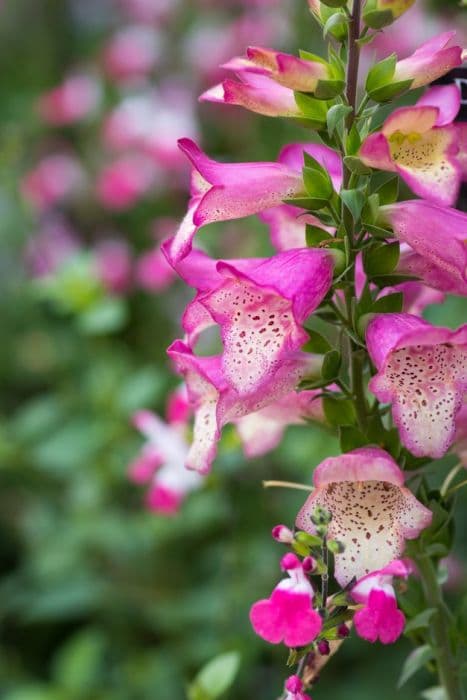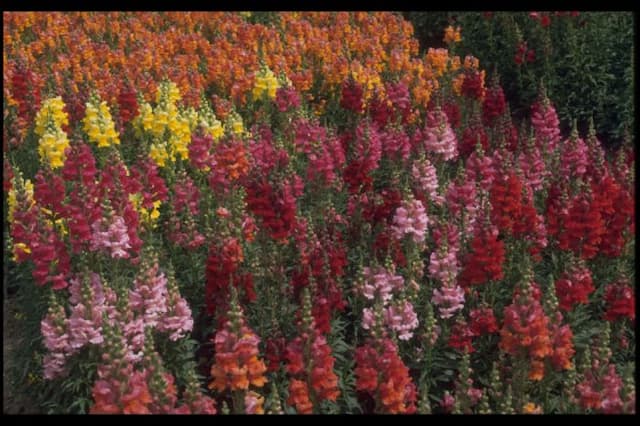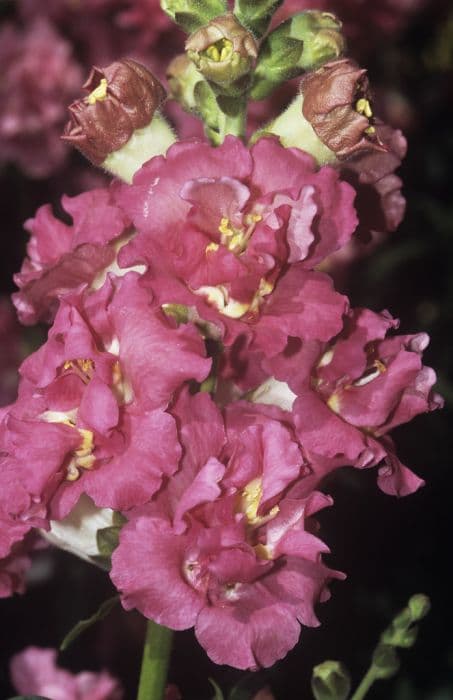Berry Canary Foxglove Digitalis × valinii 'Berry Canary'

ABOUT
The Digitalis × valinii 'Berry Canary' is a stunning garden plant commonly known as the foxglove. This particular variety stands out with vibrant pink to warm berry-colored blooms that cluster together on tall, upright spikes. The bell-shaped flowers are delicately spotted within, adding to their ornamental appeal, and they gracefully attract pollinators like bees and hummingbirds. The foliage of 'Berry Canary' is a lush green, forming a rosette at the base of the plant. The leaves range from oval to lance-shaped, with a slightly textured surface that may be veined or slightly wrinkled. The contrast between the green of the leaves and the pink to berry-hued flowers creates an attractive display when the plant is in full bloom. Overall, 'Berry Canary' adds a touch of majesty to a garden setting with its bold coloration and striking flower spikes. It’s commonly grown in borders, flower beds, and cottage gardens, where it provides height and visual interest. It is noted for its elegant and stately presence in the landscape.
About this plant
 Names
NamesFamily
Plantaginaceae
Synonyms
Berry Canary Foxglove, Illumination Berry Canary
Common names
Digitalis × valinii 'Berry Canary'.
 Toxicity
ToxicityTo humans
Foxglove, including the ‘Berry Canary’ variety, is highly toxic to humans if ingested. All parts of the plant contain cardiac glycosides, which can lead to digitalis toxicity. Symptoms of foxglove poisoning may include nausea, vomiting, diarrhea, abdominal pain, dizziness, confusion, weakness, changes in heart rate (either too slow or too fast), and possibly cardiac arrhythmias which can be life-threatening. Medical attention should be sought immediately if ingestion is suspected.
To pets
Foxglove is also highly toxic to pets, including dogs and cats. Similar to its effects on humans, the ingestion of any part of the foxglove plant can lead to digitalis toxicity. Symptoms in pets might include vomiting, diarrhea, drooling, cardiac abnormalities, weakness, lethargy, dilated pupils, or even seizures. Foxglove ingestion can be fatal for pets, so it is imperative to seek veterinary care immediately if exposure is suspected.
 Characteristics
CharacteristicsLife cycle
Perennials
Foliage type
Evergreen
Color of leaves
Green
Flower color
Pink
Height
2 feet [60 cm]
Spread
1 foot [30 cm]
Plant type
Herb
Hardiness zones
5
Native area
Hybrid
Benefits
 General Benefits
General Benefits- Aesthetic Appeal: Adds vibrant color with its bright pink-purple flowers that have an eye-catching appeal to gardens and landscapes.
- Attracts Pollinators: Its flowers attract bees, butterflies, and hummingbirds, supporting local ecosystems.
- Long Blooming Period: Offers a long season of bloom, providing color from late spring to early fall.
- Drought-Tolerant: Once established, it can tolerate periods of drought, making it suitable for water-wise gardens.
- Low Maintenance: Requires minimal upkeep beyond basic watering and occasional deadheading to promote further blooming.
- Deer and Rabbit Resistance: Has a natural resistance to browsing by deer and rabbits, which can help to protect other more vulnerable plants in the garden.
- Compact Size: Its size and mound-forming habit make it ideal for borders, containers, and small gardens.
- Versatility: Can be used in a variety of garden styles, including cottage gardens, rock gardens, or as part of a mixed perennial border.
 Medical Properties
Medical Properties- This plant is not used for medical purposes.
 Air-purifying Qualities
Air-purifying QualitiesThis plant is not specifically known for air purifying qualities.
 Other Uses
Other Uses- As a natural dye: The flowers of Foxglove can be used to produce varying shades of color for fabric dyeing, depending on the mordant used.
- In crafting and scrapbooking: Pressed Foxglove flowers can be used to decorate scrapbook pages or to craft handmade greeting cards.
- Educational purposes: Foxglove can be used in educational projects or botanical studies to demonstrate the structure of a classic flower used in traditional ornamental gardening.
- Garden wildlife habitat: Foxglove provides a source of nectar for bees and other pollinators, thus supporting local ecosystems.
- Photography prop: Its striking flowers make Foxglove a photogenic subject for garden photography and plant portraiture.
- Floral arrangements: Cut flowers of Foxglove can be used in large floral arrangements where their tall spikes add height and structure.
- Theme gardens: Foxglove can be used in fairy or fantasy-themed gardens due to its bell-shaped flowers, which are often associated with magical qualities.
- Dramatic backdrops: Because of its height and dense flower spikes, Foxglove can serve as a stunning backdrop for lower-growing plants in a layered garden bed.
- Seasonal interest: Foxglove can be used to provide a burst of color in late spring to early summer gardens.
- Wedding décor: Its flowers can add a whimsical touch to outdoor wedding ceremonies, either planted in situ or incorporated into decorations.
Interesting Facts
 Feng Shui
Feng ShuiThe plant Digitalis, commonly known as Foxglove, is not used in Feng Shui practice.
 Zodiac Sign Compitability
Zodiac Sign CompitabilityThe plant Digitalis, commonly known as Foxglove, is not used in astrology practice.
 Plant Symbolism
Plant Symbolism- Healing: Digitalis, commonly known as Foxglove, has been used in traditional medicine to make digitalin, a compound effective in treating heart conditions. The symbolism of healing derives from this medicinal application.
- Bewilderment: Foxglove's bell-like flowers can inspire a sense of enchantment or disorientation, possibly due to the plant's toxic nature when ingested, leading to a symbolic connection with bewilderment.
- Insincerity: In the language of flowers, foxglove can represent insincerity, perhaps because while the plant has medicinal properties, it can also be harmful if used improperly.
 Water
WaterFor the Foxglove 'Berry Canary', water the plant deeply once a week, allowing the soil to dry between waterings. Provide about 1 gallon of water per plant during each watering session to ensure the soil is thoroughly moistened. During hot or dry periods, you may need to water more frequently, monitoring the soil moisture to avoid over-watering. Cut back on watering in the winter when the plant is dormant, reducing to every other week or less, depending on the indoor humidity and temperature.
 Light
LightThe Foxglove 'Berry Canary' thrives best in full sun to partial shade conditions. It should be placed where it can receive at least 4-6 hours of direct sunlight per day. An eastern or western exposure is ideal for providing the light levels this plant prefers without exposing it to the harsh midday sun.
 Temperature
TemperatureFoxglove 'Berry Canary' prefers temperatures between 60°F and 80°F. The plant can tolerate a minimum temperature of around 40°F but should be protected from frost. During extreme heat, ensuring adequate moisture and some afternoon shade can help maintain the ideal temperature range.
 Pruning
PruningPrune Foxglove 'Berry Canary' to remove dead or spent flowers to encourage additional blooming and maintain a neat appearance. This should be done as soon as flowers fade, typically in late summer. Pruning in late winter to early spring helps promote healthy new growth.
 Cleaning
CleaningAs needed
 Soil
SoilThe best soil mix for Foxglove 'Berry Canary' should be well-draining and rich in organic matter. A blend of loam, peat or compost, and sharp sand or perlite is ideal. The soil pH for optimal growth should be slightly acidic to neutral, ranging from 5.5 to 7.0.
 Repotting
RepottingFoxglove 'Berry Canary' does not typically require frequent repotting and can thrive in the same container for several years. Repot only when the plant is root-bound or the soil is exhausted, which may be every 2-3 years.
 Humidity & Misting
Humidity & MistingFoxglove 'Berry Canary' prefers moderate humidity levels common in outdoor environments. It can handle regular humidity levels found in most homes if grown indoors, without requiring any special humidity adjustments.
 Suitable locations
Suitable locationsIndoor
Place in bright, indirect light with good air circulation.
Outdoor
Plant in partial shade, shelter from strong winds, enrich soil.
Hardiness zone
4-9 USDA
 Life cycle
Life cycleFoxglove 'Berry Canary' initiates its life cycle with seed germination in a moist, well-drained substrate, typically in spring or early summer. Upon sprouting, the seedlings develop into a rosette of leaves at the soil surface. Vegetative growth continues as the plant develops a strong root system and foliar structure during its first year. In the second year, the plant produces a tall spike that bears numerous pink to purple bell-shaped flowers, attracting pollinators such as bees. After pollination, the flowers develop into seed capsules that release seeds, completing the reproductive cycle. Post flowering, the biennial plant typically dies back, but it may occasionally behave as a short-lived perennial, producing new foliage and repeating the flowering cycle if conditions permit.
 Propogation
PropogationPropogation time
Spring-Early Summer
The most popular method for propagating the ‘Berry Canary’ Foxglove (Digitalis × valinii 'Berry Canary’) is by seed. To propagate by seed, start indoors before the last frost by sowing the seeds on the surface of a well-draining seed starting mix as they require light to germinate. Keep the soil moist but not waterlogged and maintain a temperature of around 65 to 70 degrees Fahrenheit (18 to 21 degrees Celsius). Germination usually occurs within 2 to 3 weeks. Once seedlings have developed their second set of true leaves, they can be transplanted into individual pots and, after the risk of frost has passed, moved outdoors to acclimatize before planting in their final positions.





![Snapdragon [Pretty in Pink]](/_next/image?url=https%3A%2F%2Fplants-admin.emdemapps.com%2Fimages%2Fplants%2F%2Fimages%2F604b5cb3b5385.png&w=640&q=75)



